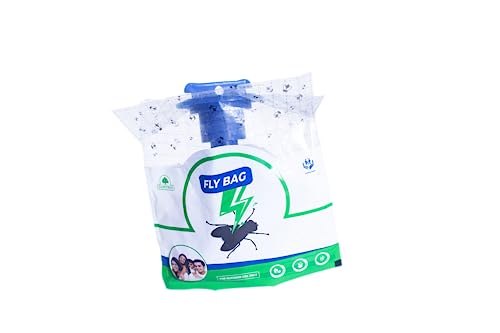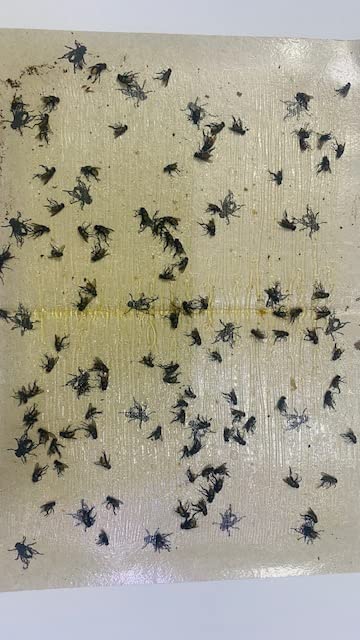-
Mejor Fly Trap Sticker Paper for Home Flies - 10 nos
Regular price Rs. 288.00Regular priceUnit price / perRs. 350.00Sale price Rs. 288.00Sale -
Yindella Fly Trap 10 Pcs Strong Power Glue Trap Fly Stick Paper Pest-Control Flies Catcher Stick Board for Kitchen Outdoor Dinning Room Outdoor Anti Fly Pest Non-Toxic Insect (10)
Regular price Rs. 399.00Regular priceUnit price / perRs. 800.00Sale price Rs. 399.00Sale -

Cactopia Disposable Fly Trap Catcher Bags Hanging Style Effective Pest Control Insect Trap - 2 Pack
Regular price Rs. 646.00Regular priceUnit price / perRs. 1,499.00Sale price Rs. 646.00Sale -
 Sale
SaleGumtree Fly Bag
Regular price Rs. 203.34Regular priceUnit price / perRs. 325.00Sale price Rs. 203.34Sale -
Spicado Traders Fly Trap for Home Glue Trap for House Fly , Sticky Fly Stick Paper Pack of 5
Regular price Rs. 248.00Regular priceUnit price / perRs. 399.00Sale price Rs. 248.00Sale -
Chipku House Fly Trap, Sticky Ribbon, Sticky Trap for houseflies roll of 50 Meter Non Toxic Fly Catcher Trap for Oudoor (1) (50 mtr, 2)
Regular price Rs. 349.00Regular priceUnit price / perRs. 450.00Sale price Rs. 349.00Sale -
Electric Fly Trap, Fly Trap PEST Device Insect Catcher Automatic Flycatcher Fly Trap PEST Reject Control Catcher Insect REPELLENTS Tools
Regular price Rs. 422.00Regular priceUnit price / perRs. 674.00Sale price Rs. 422.00Sale -
Myfam Fly Trap Sticker Paper/Sticky Traps For Home Flies - Pack Of 15, Brown
Regular price Rs. 345.00Regular priceUnit price / perRs. 399.00Sale price Rs. 345.00Sale -
Chipku House Fly Trap, Sticky Ribbon, Sticky Trap for houseflies roll of 150 Meter Non Toxic Fly Catcher Trap for Oudoor (1)
Regular price Rs. 349.00Regular priceUnit price / perRs. 499.00Sale price Rs. 349.00Sale -
Dutch and Habro Goodbye Flying Insect Trap Effective and Powerful Safe Fly Catcher (White)
Regular price Rs. 259.00Regular priceUnit price / perRs. 325.00Sale price Rs. 259.00Sale -
outdoors DDSS Dutch and Habro Goodbye Flying Insect Trap Effective and Powerful Safe Fly Catcher Pack of 1, Red
Regular price Rs. 259.00Regular priceUnit price / perRs. 375.00Sale price Rs. 259.00Sale -
Fly Glue Trap Sticker Paper/Sticky Traps For Home Flies, Pack of20 (Green)
Regular price Rs. 261.00Regular priceUnit price / perRs. 550.00Sale price Rs. 261.00Sale -
Chipku Fly Trap for Home Glue Trap for House Fly , Sticky Fly Stick Paper Pack of 10
Regular price Rs. 360.00Regular priceUnit price / perRs. 500.00Sale price Rs. 360.00Sale -
USB Powered Electric Fly Trap Automatic Fly Catcher Rotating Fly Killer Machine Pest Repellent Tool for Home Kitchen Restaurant
Regular price Rs. 999.00Regular priceUnit price / perRs. 1,499.00Sale price Rs. 999.00Sale -
Supvox® 16Pcs Fly Trap Kit for Insects, Whiteflies, Aphids, Leaf Minor, Thriphs, Yellow Ultra Sticky Trap for Insect in Garden & Farm for Indoor or Greenhouse Use Hangable Fly Sticker Paper
Regular price Rs. 399.00Regular priceUnit price / perRs. 839.00Sale price Rs. 399.00Sale
Collection: House fly control
House flies are a common nuisance in India, and their presence can pose a significant health risk to humans and animals. In houses, they can contaminate food and surfaces with harmful bacteria, while in dairies and poultry farms, they can spread diseases among livestock. Effective control of house flies in these settings is essential for protecting public health and ensuring the well-being of animals.
Prevalence and Impact of House Flies in India
House flies are ubiquitous in India, found in both urban and rural areas. Their ability to thrive in a variety of environments, including homes, restaurants, hospitals, farms, and garbage dumps, makes them a major public health concern. These flies are known to carry a variety of pathogens, including bacteria, viruses, and protozoa, which can cause a range of illnesses, including diarrhea, dysentery, typhoid fever, and cholera.
In dairies, house flies can spread diseases such as mastitis, which can reduce milk production and cause economic losses for farmers. They can also contaminate milk with bacteria, making it unsafe for consumption. Similarly, in poultry farms, house flies can spread diseases such as salmonellosis and Newcastle disease, which can cause significant mortality among birds.
Strategies for House Fly Control
Effectively controlling house flies requires a comprehensive approach that addresses both prevention and intervention measures.
Prevention:
-
Eliminate breeding sites: House flies lay their eggs in decaying organic matter, such as manure, rotting food, and garbage. Proper sanitation and waste management are crucial to prevent breeding sites from developing.
-
Maintain hygiene: Regularly clean and disinfect surfaces, especially in kitchens and food preparation areas, to eliminate food sources for flies. Store food in airtight containers and dispose of garbage promptly.
-
Exclude flies: Seal cracks and gaps around windows, doors, and vents to prevent flies from entering buildings. Use screens on windows and doors to further deter entry.
-
Reduce attractants: Avoid leaving out open food or beverages, and clean up spills promptly. Remove pet waste daily to prevent it from attracting flies.
Intervention:
-
Fly traps: Utilize sticky traps, baited traps, and electronic traps to capture adult flies. These traps can be particularly effective in areas where flies are concentrated.
-
Insecticides: In severe infestations, insecticides may be necessary to eliminate large populations of flies. Choose insecticides with low toxicity and carefully follow label instructions.
-
Biological control: Introduce natural predators of house flies, such as parasitic wasps or nematodes, to reduce fly populations in an eco-friendly manner.
Importance of Integrated Pest Management
An integrated pest management (IPM) approach is essential for effective and sustainable house fly control. IPM combines preventive measures, such as sanitation and habitat modification, with targeted interventions, such as traps and insecticides, to reduce fly populations while minimizing environmental impact.
By implementing a comprehensive IPM strategy, households, dairies, and poultry farms can significantly reduce the presence of house flies, mitigate their health risks, and protect the well-being of humans and animals.















